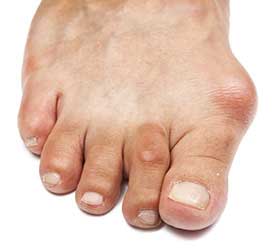Bunions Treatment in Weatherford, TX

What are Bunions?
A bunion is often described as a bump on the base of the big toe along the metatarsophalangeal (MTP) joint, but there is much more to a bunion than its appearance. The visible bump on the foot indicates changes in the bony framework of the front part of the foot. Bunions cause the big toe to lean toward the second toe rather than pointing straight ahead. This misalignment causes the MTP joint to become stiff and/or sore, making simple tasks like walking or even wearing shoes difficult or impossible.
Bunions are a progressive disorder, meaning they develop and grow slowly over time. They develop when too much pressure falls unevenly on the joints and tendons in the feet. This imbalance in pressure makes the big toe unstable, eventually molding the parts of the joint into a hard bump. Patients may also experience swelling, soreness and redness around the base of the big toe that can cause persistent or intermittent pain.
Causes of Bunions
The primary cause of a bunion is mechanical instability in the MTP joint at the base of the big toe. There are a number of reasons why this happens, but it is most often due to poor shoe choice or, in some cases, genetics. Bunions appear to be hereditary, but it is the foot type that is passed down, not the condition itself. Parents who suffer from poor foot mechanics often pass their problematic foot type on to their children. Other risk factors include:
- Arthritis conditions: Weakened ligaments triggered by rheumatoid arthritis often cause joint deformities in the foot. When deformities occur on the forefoot (the toes and ball of the foot), bunions can form.
- Age/gender: Studies have found that women are more likely than men to have bunions as they grow older, especially after age 50. This is often attributed to poor shoe choices over long periods of time, including high heels or narrow, tight-fitting shoes.
- Poor foot posture: Patients with low arches, flat feet, and loose joints or tendons are at an increased risk of developing bunions because these issues cause mechanical imbalances in the feet.
- Past injury/trauma: Foot injuries sustained through physical activity like exercise can cause bunions if they're left untreated.
Tight footwear is thought to be the main cause of bunions, especially high-heeled and narrow-toed shoes. Wearing such shoes puts extra pressure on the MTP joint and causes friction with the overlying skin. This friction causes inflammation and swelling at the base of the toe, which becomes increasingly painful over time. Proper shoe choice is critical in preventing and managing bunions.
Diagnosis and Treatment of Bunions
A bunion can cause the foot to become deformed, and it is often pain that leads people to contact their physicians. A doctor will start by evaluating the symptoms the patient is experiencing and examining the affected foot for joint enlargement, tissue swelling and/or tenderness. In most cases, an x-ray of the foot will be taken to assess the alignment of the big toe. Once the condition of the bunion is assessed, the doctor will begin treatment.
Non-surgical treatment is most effective in the initial stages of a bunion's development, and early detection is crucial for patients who hope to avoid surgery. Removing pressure from the bunion is the first step in the treatment process. This can be done by simply changing the shoes you wear. If the condition persists, your doctor can employ other non-surgical treatment methods, including:
- Padding/taping: Padding a bunion minimizes pain and relieves pressure.
- Medication: Anti-inflammatory drugs are often prescribed to decrease the pain and inflammation joint deformities cause.
- Physical therapy : Regular, guided exercise is useful in relieving inflammation and pain.
- Custom foot orthotics : Shoe inserts help control foot function, reduce pain and prevent future misalignment.
When the bunion has progressed too far for non-surgical treatment methods, podiatric surgery may become necessary. There are a number of surgical procedures available to treat bunions, and each procedure is designed to remove the bump, correct any misalignment in the bony structure of the foot and correct any soft tissue changes that may have occurred.
Request more information about bunion treatment today. Call (817) 203-2760 or contact The New You Medical & Infusion Clinic online.
The New You Medical & Infusion Clinic
Address
100 Grapevine HwyHurst, TX 76054
(817) 203-2760
https://www.newyoumedclinic.com/
Hours
Mon:
10:00 am - 6:00 pm
Tue:
10:00 am - 6:00 pm
Wed:
10:00 am - 6:00 pm
Thu:
10:00 am - 6:00 pm
Fri:
Closed
Sat:
Closed
Sun:
Closed

